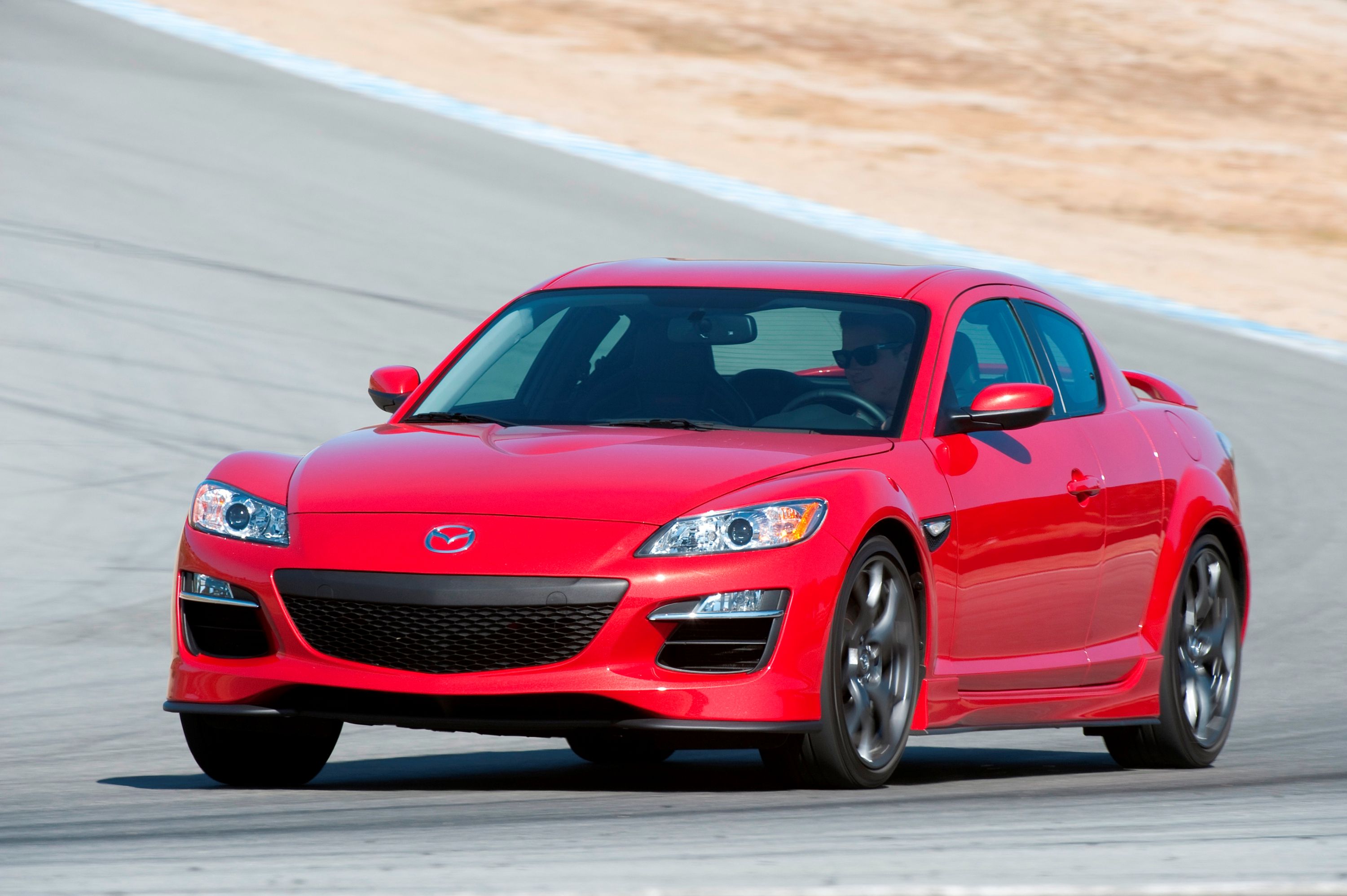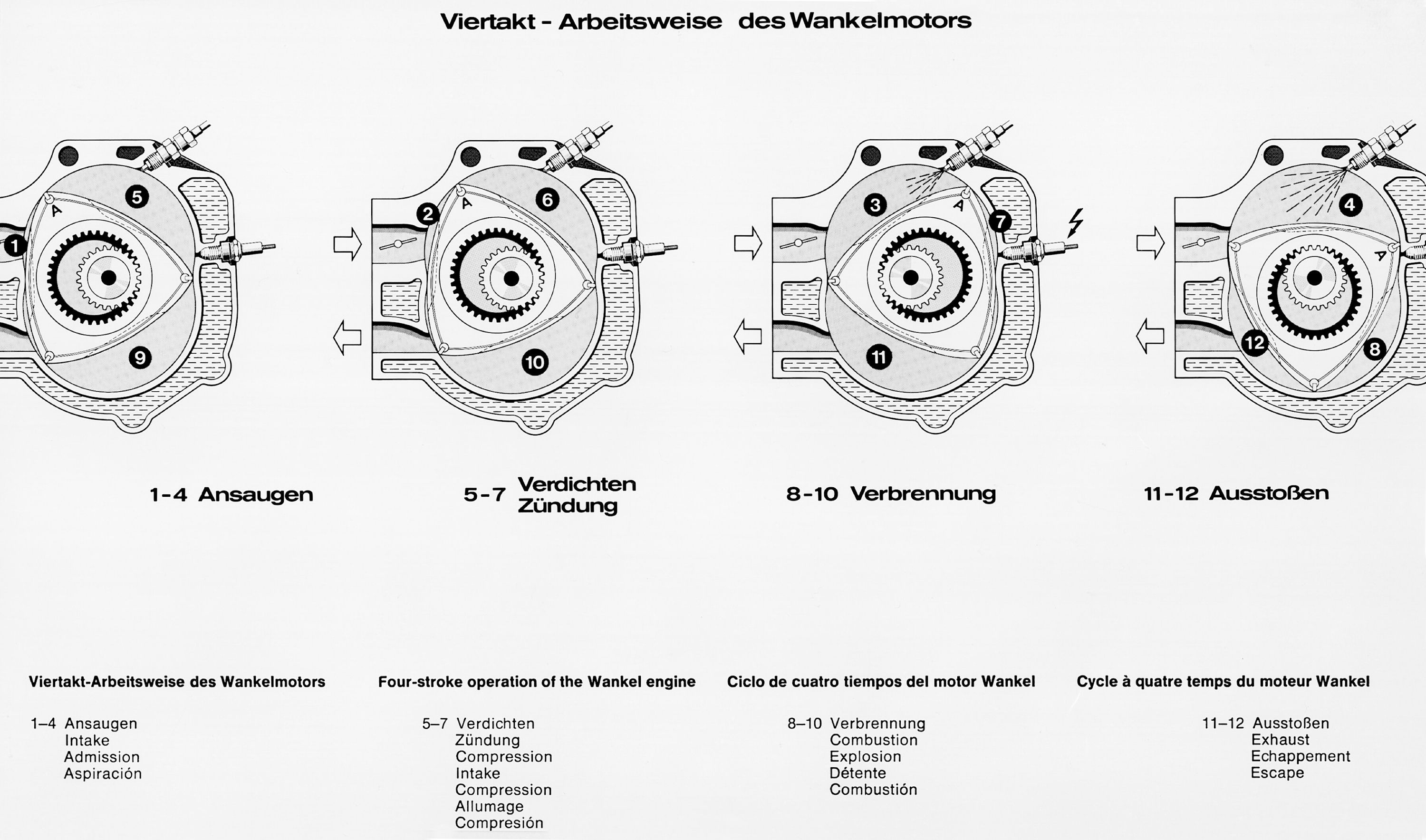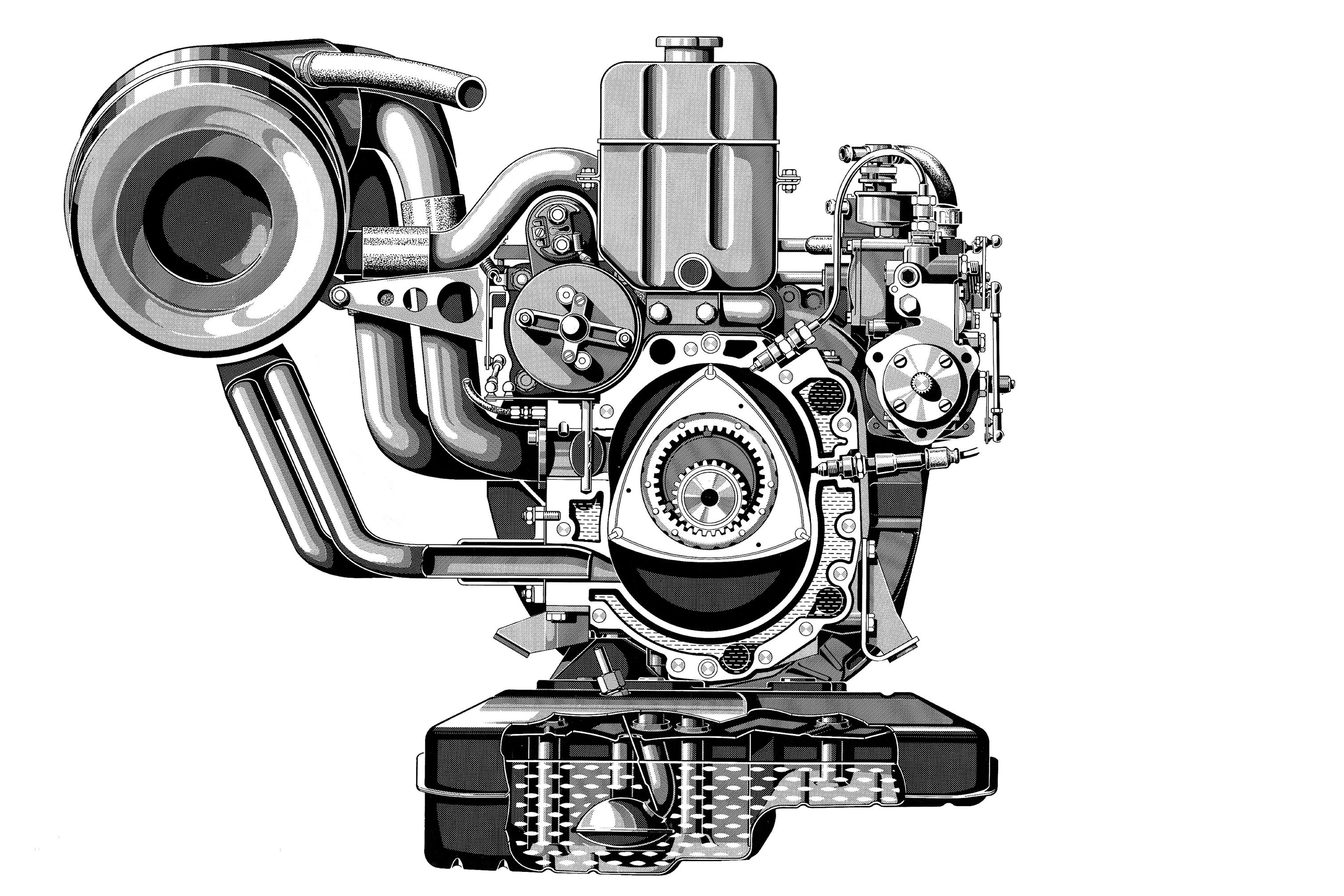
How Does a Rotary Engine Work?
A basic dictionary definition gets us halfway to explaining a rotary engine: a rotary motion is essentially something revolving around a center axis. In this case, a triangular rotor is spinning around an output shaft, which leads us to the next question - so, what is a rotary engine? The rotary engine has one thing in common with the traditional piston engine: internal combustion, and that's about it. Unlike a conventional internal combustion engine, which has cylinder banks, rods, a crankshaft, and pistons, a rotary engine consists of these three essential parts:
- A barrel-shaped housing
- Triangular rotor
- Output shaft
There are other components, like an intake and outlet port and spark plugs to ignite the fuel, but a rotary engine only has these three major components, which is part of what makes it so attractive. In trying to answer the question, "How does a rotary engine work?", the easiest way to explain it is as follows. Imagine a side-on diagram in the shape of a barrel. Inside the barrel-shaped (oval) combustion housing, there are two or three triangular rotors. The open spaces between the rotors and the housing are known as chambers. As with a typical car, fuel and air are mixed and ignited by a sparkplug, moving the rotors around a fixed output shaft. The rotors and output shaft are connected, which supplies power to the wheels. Every other engine configuration, including the inline, V, VR, and W configurations use what we know as a traditional piston.
Specifications
A rotary engine's specifications can be misleading. It's small, but it packs a punch. Well, at least in the horsepower department. The last production car to use a rotary engine was the Mazda RX-8. The engine specs for the RX-8 are as follows:
- 1.3-liter
- 232 horsepower at 8,500 rpm
- 159 lb-ft at 5,500 rpm
As you can see from the specifications above, you can't rely on engine displacement to estimate the power output. A 1.3-liter traditional piston engine would struggle to deliver 100 hp, but a similarly-sized rotary engine packs a 232 hp punch. And without the help of forced induction. The low torque output is also a mainstay of the rotary motor.
Types of Rotary Motor
Usually, we categorize engine types according to size, number of cylinders, and engine configurations. Since the rotary engine is less complex, most production vehicles had two or three triangular rotors. Both the Mazda RX-7 and RX-8 had a 2-rotor layout, for example. There have been engines with more rotors than that, but these units were most often once-off builds for racing cars.
The main difference between rotary engines is in the cooling department.
- Oil cooling: This method is most commonly used in mass production, and it works. As you can imagine, rotary engine cars require a lot more oil than a piston car. There's a lot more friction, which requires more oil. This is particularly tricky, considering that there has to be a tight seal between the triangular rotors and the walls of the combustion chamber.
- Charge cooling: In this setup, the engine uses induction air to cool down the triangular rotors. It's not a perfect solution, as engines prefer cooler air when it comes to combustion.
- Cooling via ambient air: This is the same basic method as above, but instead of using the intake system, it uses a separate port that blows ambient air directly onto the rotors. Having a separate opening is not ideal either. It leads to even more oil loss on an already oil-thirsty engine configuration.
History and Evolution of the Wankel Rotary Engine
The first rotary engine was designed by Felix Wankel in 1951. That's why rotary engines are also known as a Wankel motor, or more formally, the Wankel Rotary Engine. The design was then perfected by a man called Hanns Dieter Paschke. Wankel's version of the rotary was codenamed DKM. In his version, the housing and rotor spun on separate axes. It could rev much higher, but the complexity made it unviable from a mass-production point of view. Looking at a cutout of the DKM, you can see why. The entire engine would have to be disassembled to change a simple sparkplug. Paschke introduced the fixed housing with intakes, outlets, and spark plugs on the outside. According to legend, Wankel wasn't happy about this. He wanted to build racecar engines, while Paschke's focus was on simplicity.
Both men were employed by NSU Motorenwerke, who signed various licensing agreements with well-known automotive manufacturers like Nissan, Porsche, Mercedes-Benz, and even Rolls-Royce. Only one manufacturer chose to mass-produce the rotary engine over an extended period, and as you've probably guessed by now, it's Mazda. Mercedes-Benz deserves a special mention for the C111, though it never went past the concept phase. Most engines never made it past the initial test phase.
Mazda's first batch of rotary-engined cars was a flop. The Cosmo 110S was assembled by hand, and Mazda cut it from the line-up in 1972. Less than 1,500 were made. The Cosmo name soldiered on, but with traditional inline four-cylinder power.
The rotary engine only returned with the introduction of the now-famous RX-7. The third-generation twin-turbocharged model is considered an icon these days. It had a 1.3-liter engine, spurred on by a horribly complex turbocharging system. One turbocharger kicked in at 1,800 rpm, while the second took over at 4,000 rpm. This twin-turbo system was widely adopted in recent years, but back in 1992, it was mind-blowing. Mazda was able to extract 276 hp and 231 lb-ft of torque from a 1.3-liter motor. Even though the RX-7 won multiple awards, production was limited to less than 69,000 units. It was only really appreciated after its demise. Earlier generations are pretty easy to find for less than $10,000. A decent third-generation used Mazda RX-7 starts at around $50,000 these days.
Mazda tried once more with the RX-8, but it was not to be. This brilliant little car had its upsides, like revving to 8,500 rpm and sharp handling characteristics. On the downside, it was expensive to maintain, thirsty, and had notoriously frail electronics. Will there be another Wankel car? It's doubtful. Mazda has moved on to turbocharged four-cylinder engines and will launch its first electric car (MX-30) next year.
What Cars Use a Rotary Engine?
If you're asking 'what cars have rotary engines' today, you'll be disappointed to know there are no current examples to cite, and the aforementioned older Mazdas are the most famous. There are a few other examples of rotary-engined cars worth mentioning, but all of them never made it past the concept phase.
- Audi A1 e-tron (concept car): Before launching the actual e-tron, Audi fooled around with the name circa 2010. This A1 concept had a small rotary engine, but it wasn't used to power the wheels. Instead, it powered a small onboard generator that powered the electric motor once the battery was depleted. It's a very similar system to what BMW would eventually use in the i3.
- Chevrolet Aerovette: This one dates back to the 1970s. It was one of the first mid-engined Corvette concepts, and its two-rotor motor produced 420 hp. As you know, we had to wait until the current Chevrolet Corvette to finally find out what a mid-engined model would be like.
- Mercedes-Benz C111: Mercedes also played around with a mid-engined model in the 1970s. The C111 first had a three-rotor layout, which was eventually increased to a four-rotor engine. According to reports, its 2.4-liter engine produced 350 hp. Merc even played around with the idea of a diesel rotary engine.
- AMC Pacer: The American Motors Corporation, known as AMC, was planning on putting the Pacer into production with a rotary engine. Unfortunately, the contract between NSU and the US firm fell through. It also didn't help that the USA went through insane fuel increases at the time.
Pros and Cons of Rotary Engines
The rotary engine had a few things counting in its favor, but there were too many other factors that outweighed these. Pros and cons of the rotary engine can be summarized like this:


